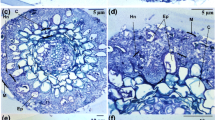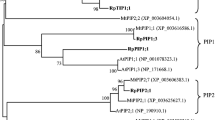Abstract
The formation of ectomycorrhizas, a tight association between fine roots of trees and certain soil fungi, improves plant nutrition in a nutrient-limited environment and may increase plant survival under water stress conditions. To investigate the impact of mycorrhiza formation on plant water uptake, seven genes coding for putative water channel proteins (aquaporins) were isolated from a poplar ectomycorrhizal cDNA library. Four out of the seven genes were preferentially expressed in roots. Mycorrhiza formation resulted in an increased transcript level for three of these genes, two of which are the most prominently expressed aquaporins in roots. When expressed in Xenopus laevis oocytes, the corresponding proteins of both genes were able to transport water. Together, these data indicate, that the water transport capacity of the plasma membrane of root cells is strongly increased in mycorrhized plants. Measurements of the hydraulic conductance of intact root systems revealed an increased water transport capacity of mycorrhized poplar roots. These data, however, also indicate that changes in the properties of the plasma membrane as well as those of the apoplast are responsible for the increased root hydraulic conductance in ectomycorrhizal symbiosis.





Similar content being viewed by others
Abbreviations
- EM:
-
Ectomycorrhiza
- MIP:
-
Membrane intrinsic protein
- PIP:
-
Plasma membrane intrinsic protein
- TIP:
-
Tonoplast intrinsic protein
- NIP:
-
Nodulin-intrinsic protein
- SIP:
-
Small intrinsic protein
- P f :
-
Osmotic permeability coefficient
- K r :
-
Hydraulic conductance
- L p :
-
Hydraulic conductivity
- E a :
-
Activation energy
- PCR:
-
Polymerase chain reaction
References
Altschul S, Thomas L, Alejandro A, Jinghui Z, Zheng Z, Webb M, David J (1997) Gapped BLAST and PSI-Blast: a new generation of protein database search programs. Nucl Acids Res 25:3389–3402
Azaizeh H, Gunse B, Steudle E (1992) Effects of NaCl and CaCl2 on water transport across root cells of maize (Zea mays L.) seedlings. Plant Physiol 99:886–894
Biela A, Grote K, Otto B, Hoth S, Hedrich R, Kaldenhoff R (1999) The Nicotiana tabacum plasma membrane aquaporin NtAQP1 is mercury-insensitive and permeable for glycerol. Plant J 18:565–570
Boyle CD, Hellenbrand KE (1991) Assessment of the effect of mycorrhizal fungi on drought tolerance of conifer seedlings. Can J Bot 69:1764–1771
Chaumont F, Barrieu F, Wojcik E, Chrispeels MJ, Jung R (2001) Aquaporins constitute a large and highly divergent protein family in maize. Plant Physiol 125:1206–1215
Gerbeau P, Amodeo G, Henzler T, Santoni V, Ripoche P, Maurel C (2002) The water permeability of Arabidopsis plasma membrane is regulated by divalent cations and pH. Plant J 30:71–81
Goss RW (1960) Mycorrhizae of ponderosa pine in Nebraska grassland soils. Res Bull 192:35–47
Grunze N, Willmann M, Nehls U (2004) Impact of ectomycorrhiza formation on monosaccharide transporter gene expression in poplar roots. New Phytol 164:147–156
Guerrero FD, Jones JT, Mullet JE (1990) Turgor-responsible gene transcription and RNA levels increase rapidly when pea shoots are wilted. Sequence and expression of three inducible genes. Plant Mol Biol 15:11–26
Hampp R, Ecke M, Schaeffer C, Wallenda T, Wingler A, Kottke I, Sundberg B (1996) Axenic mycorrhization of wild type and transgenic hybrid aspen expressing T-DNA indolacetic acid-biosynthesis genes. Trees 11:59–64
Huelsenbeck JP, Larget B, Miller RE, Ronquist F (2002) Potential applications and pitfalls of Bayesian inference of phylogeny. Syst Biol 51:673–688
Johansson U, Karlsson M, Johansson I, Gustavsson S, Sjövall S, Fraysee L, Weig A, Kjellbom P (2001) The complete set of genes encoding major intrisic proteins in Arabidopsis provides a framework for a new nomenclature for major intrinstic proteins in plants. Plant Physiol 126:1358–1369
Kaldenhoff R, Eckert M (1999) Features and function of plant aquaporins. J Photochem Photobiol 52:1–6
Kaldenhoff R, Kolling A, Richter G (1993) A novel blue light- and abscisic acid-inducible gene of Arabidopsis thaliana encoding an intrinsic membrane protein. Plant Mol Biol 23:1187–1198
Kaldenhoff R, Grote K, Zhu JJ, Zimmermann U (1998) Significance of plasmalemma aquaporins for watertransport in Arabidopsis thaliana. Plant J 14:121–128
Kyte J, Doolittle RF (1982) A simple method for displaying the hydropathic character of a protein. J Mol Biol 157:105–132
Landhäusser SM, Muhsin TM, Zwiazek J (2002) The effect of ectomycorrhizae on water relations in aspen (Populus tremuloides) and white spruce (Picea glauca) at low soil temperatures. Can J Bot 80:684–689
Lehto T (1992) Mycorrhizas and drought resistance of Picea sitchensis (Bong) Carr I. In condition of nutrient deficiency. New Phytol 122:661–668
Loewe A, Einig W, Shi L, Dizengremel P, Hampp R (2000) Mycorrhiza formation and elevated CO2 both increase the capacity for sucrose synthesis in source leaves of spruce and aspen. New Phytol 145:565–574
Maurel C, Chrispeels MJ (2001) Aquaporins. A molecular entry into plant water relations. Plant Physiol 125:135–138
Morillon R, Lassalles JP (2002) Water deficit during root development: effects on the growth of roots and osmotic water permeability of isolated root protoplasts. Planta 214:392–399
Morte A, Diaz GR, P. Alarcon JJ, Sanchez-Blanco MJ (2001) Growth and water relations in mycorrhizal and nonmycorrhizal Pinus halepensis plants in response to drought. Physiol Plant 44:263–267
Moshelion M, Becker D, Biela A, Uehlein N, Hedrich R, Otto B, Levi H, Moran N, Kaldenhoff R (2002) Plasma membrane aquaporins in the motor cells of Samanea saman: diurnal and circadian regulation. Plant Cell 14:727–739
Muhsin TM, Zwiazek JJ (2002) Ectomycorrhizas increase apoplastic water transport and root hydraulic conductivity in Ulmus americana seedlings. New Phytol 153:153–158
Nehls U, Bock A, Ecke M, Hampp R (2001) Differential expression of hexose-regulated fungal genes within Amanita muscaria Populus tremula x tremuloides ectomycorrhizas. New Phytol 150:583–589
Parke JL, Linderman RG, Black CH (1983) The role of ectomycorrhizas in drought tolerance of Douglas-fir seedlings. New Phytol 95:83–95
Phillips AL, Huttly AK (1994) Cloning of two giberellin-regulated cDNAs from Arabidopsis thaliana by subtractive hybridization: Expression of the tonoplast water channel, TIP, is increased by GA3. Plant Mol Biol 24:603–615
Ramahaleo T, Morillon R, Alexandre J, Lassalles JP (1999) Osmotic water permeability of isolated protoplasts. Modifications during development. Plant Physiol 25:885–896
Rieger M, Litvin P (1999) Root system hydraulic conductivity in species with contrasting root anatomy. J Exp Bot 50:201–209
Sambrook J, Fritsch E, Maniatis T (1989) Molecular Cloning. A Laboratory Manual. Cold Spring Harbor Laboratory Press, New York
Siefritz F, Tyree MT, Lovisolo C, Schubert A, Kaldenhoff R (2002) PIP1 plasma membrane aquaporins in tobacco: from cellular effects to function in plants. Plant Cell 14:869–876
Smith SE, Read DJ (1997) Mycorrhizal Symbiosis, vol 2. Academic, London
Steudle E, Peterson CA (1998) How does water get through roots. J Exp Bot 49:775–788
Thompson JD, Gibson TJ, Plewniak F, Jeanmougin F, Higgins DG (1997) The ClustalX windows interface: flexible strategies for multiple sequence alignment aided by quality analysis tools. Nuc Acids Res 24:4876–4882
Tyree MT (1997) The cohesion-tension theory of sap ascent: current controversies. J Exp Bot 48:1753–1765
Uehlein N, Lovisolo C, Siefritz F, Kaldenhoff R (2003) The tobacco aquaporin NtAQP1 is a membrane CO2 pore with physiological functions. Nature 425:734–737
Wan X, Zwiazek JJ (1999) Mercuric chloride effects on root water transport in aspen (Populus tremuloides) seedlings. Plant Physiol 121:939–946
Weig AR, Jakob C (2000) Functional identification of the glycerol permease activity of Arabidopsis thaliana NLM1 and NLM2 proteins by heterologous expression in Saccharomyces cerevisiae. FEBS Let 481:293–298
Wright DP, Scholes JD, Read DJ, Rolfe SA (2000) Changes in carbon allocation and expression of carbon transporter genes in Betula pendula Roth. colonized by the ectomycorrhizal fungus Paxillus involutus (Batsch) Fr. Plant Cell Env 23:39–49
Yamaguchi J, Koizumi M, Urao S, Shinozaki K (1992) Molecular cloning and characterization of 9 cDNAs for genes that are responsible to desiccation in Arabidopsis thaliana: sequence analysis of one cDNA clone that encodes a putative transmembrane channel protein. Plant Cell Physiol 33:217–224
Zhang R, Verkman AS (1991) Water and urea permeability properties of Xenopus oocytes: expression of mRNA from toad urinary bladder. Am J Physiol 260:C26–C34
Acknowledgements
We are indebted to Margret Ecke, Tawfik Muhsin and Andrea Bock for excellent technical assistance and to Dr. Nina Grunze for critical reading of the manuscript. This work was financed by the Deutsche Forschungsgemeinschaft (Ha 970/10-1 and Ne 332/7-1) as part of the focus program SSP1084 ”Molekulare Grundlagen der Mykorrhiza Symbiose”.
Author information
Authors and Affiliations
Corresponding author
Rights and permissions
About this article
Cite this article
Marjanović, Ž., Uehlein, N., Kaldenhoff, R. et al. Aquaporins in poplar: What a difference a symbiont makes!. Planta 222, 258–268 (2005). https://doi.org/10.1007/s00425-005-1539-z
Received:
Accepted:
Published:
Issue Date:
DOI: https://doi.org/10.1007/s00425-005-1539-z




